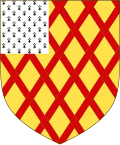| Arms | Name | Dates of office | Notes | Ref |
|---|
 | Sir Algar Howard | 1943–1944 | Howard was descended from the Dukes of Norfolk; he was born in Thornbury Castle, where he lived for many years. [5] Educated at King's College London, [6] he was later admitted to the Inner Temple as a barrister. His first appointment at the College was in May 1911 as Fitzalan Pursuivant Extraordinary and he attended the Investiture of Edward, Prince of Wales that year. [6] He was promoted to Rouge Dragon Pursuivant that October, followed by Windsor Herald in 1919 and Norroy King of Arms in 1931, to which was added Ulster King of Arms in 1943. [6] After he resigned as Garter, he served as Extra Gentleman Usher to Queen Elizabeth II from 1952 till his death, aged 89, in 1970. [5] [7] | [6] |
|---|
 | Sir Gerald Wollaston | 1944–1957 | A grandson of Sir Albert William Woods, [8] Wollaston was educated at Harrow School and then Trinity College, Cambridge, where he graduated in 1893 with a law degree. [9] [10] He was called to the Bar in 1899, but joined the College three years later as Fitzalan Pursuivant Extraordinary for the coronation of Edward VII. Appointments as Bluemantle Pursuivant (1906), Richmond Herald (1919), and Norroy King of Arms (1928) followed. [9] Having served as Henry Farnham Burke's deputy for a year, [9] he succeeded him as Garter and oversaw the coronation of George VI; his experience and knowledge of ceremonial proved useful in assisting the young Earl Marshal. Earlier in his career, he was often called on to counsel in peerage cases. [10] A "most painstaking and skilled herald with special bent to ceremonial", he published The Court of Claims in 1902, 1910 and 1936. [9] After his Gartership, he served as Norroy and Ulster until his death in 1957. [10] | [9] |
|---|
 | Aubrey Toppin | 1957–1966 | | |
|---|
 | Richard Graham-Vivian | 1966–1971 | | |
|---|
 | Sir Walter Verco | 1971–1980 | | |
|---|
 | John Brooke-Little | 1980–1995 | Brooke-Little was educated at Clayesmore School and New College, Oxford, where his interest in heraldry grew and his friends included the future Garter, Colin Cole. He joined the Earl Marshal's staff in 1952 and was a Gold Stick Officer at the coronation in 1953. Appointed Bluemantle Pursuivant in 1956 and Richmond Herald in 1967, Brooke-Little also served as Registrar at the College (1974–82), Norroy and Ulster King of Arms and Registrar of the Order of St Patrick (1980–85) and director of the Heralds' Museum from 1991 until his retirement. He founded the Heraldry Society in 1947 and was its Chairman for fifty years, after which he was its President; he edited its journal, The Coat of Arms, until 2004. His published work included updated editions of Boutell's Heraldry and Fox-Davies's Complete Guide to Heraldry. According to The Daily Telegraph , he was the "brightest and ablest herald of his generation", but did not attain Gartership partly due to his "chaotic working practices". He died in 2006. | [11] [12] [13] |
|---|
 | Hubert Chesshyre | 1995–1997 | After attending Trinity College, Cambridge, and Christ Church, Oxford, and graduating from both universities, Chesshyre became Rouge Croix Pursuivant in 1970, before serving as Chester Herald between 1978 and 1995 and Honorary Genealogist to the Royal Victorian Order from 1987 to 2010. He has been a member of the Westminster Abbey Architectural Advisory Panel and the Heraldry Society's Council. Along with Thomas Woodcock, he co-authored the Dictionary of British Arms: Medieval Armorial, volume 1. | [14] [15] |
|---|
 | Thomas Woodcock | 1997–2010 | Woodcock was educated at Durham University and Darwin College, Cambridge. He was called to the Bar in 1975, but started work as a research assistant to Sir Anthony Wagner that year. He was appointed Rouge Croix in 1978, Somerset in 1982 and Norroy and Ulster in 1997. He has co-authored a number of works on heraldry, including The Oxford Guide to Heraldry (1988) and all four volumes of Dictionary of British Arms: Medieval Ordinary (1992–2014). [16] | [17] [18] |
|---|
 | Patric Dickinson | 2010 | Dickinson was educated at Exeter College, Oxford, and was President of the Oxford Union in 1972. A research assistant at the College of Arms since 1968, his first heraldic appointment was ten years later, when he became Rouge Dragon Pursuivant. Promotions to Richmond Herald (1989) and Norroy and Ulster King of Arms (2010) followed, before he became Clarenceux. Having served as the College's Treasurer since 1995, Dickinson was also the Earl Marshal's Secretary from 1996 to 2012 and has been President of the Society of Genealogists since 2005. | [19] [20] |
|---|
 | Sir Henry Paston-Bedingfeld | 2010–2014 | | |
|---|
 | Timothy Duke | 2014–2021 | | |
|---|
 | Robert Noel | 2021–2024 | | |
|---|
 | Clive Cheesman | 2024–present | | [21] |
|---|
|


































































































